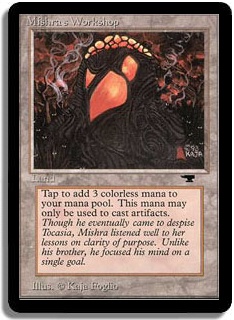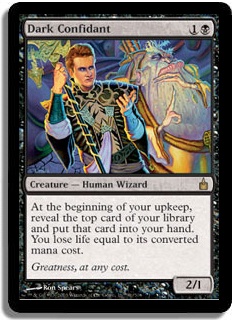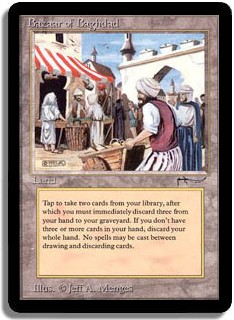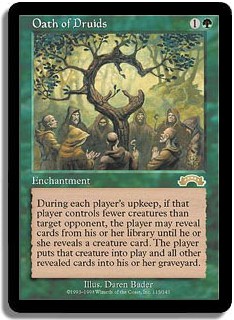Another Gen Con and Vintage Championship have come and gone into the history books, and what a time it was! Gen Con is an amazing half week for Vintage because there is simply a ton of it constantly being played by a wide variety of people from all over the world. I spent my Gen Con time hanging out with Smennen, Paul Mastriano, Kevin Cron, Theo, and my girlfriend Rebecca who came out to experience her first Gen Con ever.
All things considered, if the objective of Gen Con was to win Vintage Champs (and not to have fun in the abstract), my Gen Con was a complete and utter disaster. The Gen Con thread from www.themanadrain.com describes my record as 0-2 drop, when in reality it was actually much worse than that.
“I Delved all the way to the bottom…”
I had a career bad (for any format ever) 0-4 drop performance playing Soly’s RUG Delver deck. With that being said, I would like to thank Soly for helping me out and sharing his insights about the deck with me before the tournament, to congratulate him for his success in the prelim and in the main event, and specifically to put forward that my poor result with the deck in this particular tournament really does injustice to the fact that the deck is very good. I enjoyed playing the deck, I like the deck, and I do think it is quite good and appreciated his help and insights. Based on the information I had going into the event (which was largely tainted by my own biases and preferences), RUG Delver was my choice.
My deck selection was widely influenced by the recent success of U/W Bomberman, U/R Landstill, and RUG Delver itself over the course of the past few months. Specifically, the tournament data that I was looking at led me to believe that these types of decks were better than they really are and therefore must be accounted for with regard to one’s deck selection. I spent too much time focused on beating ‘fair’ decks through modes that were also decidedly ‘fair,’ and because of that I simply didn’t recognize that, as is always the case, Vintage is not actually about being fair!
Creatures (15)
Lands (15)
Spells (30)

I have quite a bit of experience playing decks like this, especially ported from other formats like Legacy and Modern, so I felt comfortable actually playing the deck with regard to technical play. Also, watching Soly handily crush the first Vintage prelim tournament with the deck was a big vote of confidence for RUG Delver being a solid choice going into the tournament. I sleeved it up and battled a ton of games the night before primarily against Bant, Landstill, and RUG—three decks that I felt would be popular choices. Â
Unfortunately, my pairings for the actual event did not in any way resemble what I had prepared to play against, though I did very accurately predict the field and how it would perform. My prediction for Top 8 was: three Workshop, two Dredge, one Bomberman, one Key/Vault Control, one RUG. In reality it turned out to be minus one RUG and plus Workshop deck number four.
Anyway, let’s get back to me getting my face curb stomped in during the Swiss rounds. My pairings were: Esper Control, Intuition Tendrils Control, and then two Strix Control. Have you ever had one of those tournaments where absolutely nothing goes your way? Well, this was one of those events for me.
- I lost three of four die rolls.
- In six of the eight games I lost, my opponent cast Ancestral Recall on turns 1 or 2 without Tutoring for it.
- In four of the six where they had Ancestral Recall, they also had the natural Black Lotus to go with it.
- In six of the eight games, my opponent had Academy and two artifact mana by turn 2 (which was relevant because it blanked my lethal Lightning Bolt with Flusterstorm backup three times).
- Every single game I played (besides the one where my opponent Tinkered for Blightsteel Colossus on turn 2 with Force of Will backup), I got my opponent to less than three life.
I am not relaying this information because I mean to complain about my bad beats or because I want my readers to pity me. I certainly don’t pity myself and recognize that there are much better combinations of 75 cards that I could have played for this specific event.
The five bullet points from above serve as my tournament report for Vintage Champs. I think that particularly bad luck with regard to draws and pairings caused me to get crushed immediately out of the event; however, I also feel that with a larger sample size (say I got to replay the event ten times with different pairings and different draws) that the majority of my end results would probably have fallen short of the goal, which was Top 8 and possibly a tournament victory.
My support for this claim is that Soly, Jimmy M., and Paul M. all played functionally the same deck as me and all ended up in the Top 16. All three are very good players that fell short of their goals with the same deck. I certainly have the hindsight to recognize that there were significantly better options available for the event, and had I known that I would have done things very differently. But everybody is a pretty sick hindsight predictor of current success, and I think that the deck I played was much better than a 0-4 drop kind of a deck.
Therefore, the problem with RUG probably wasn’t the play skill of the pilots, but rather inherent problems with the archetype that are made more clear in a 200-man, eight-round tournament.
The key is that they all ended up in the Top 16 of the tournament and none were able to crack into the threshold of the Top 8, which is very telling of what the RUG Delver deck really is. It is pretty clear to me after playing this tournament that the pillars of Vintage are fairly well established and cemented (at least until further printings possibly shake things up a little).
Here is what I learned about the pillars of Vintage:
TIER I:
TIER 1.5
TIER 2
EVERYTHING ELSE
Unfortunately, this is just a teaser for you to think about for a while, and I have more specific content to discuss before I return to justify these claims with evidence later in the article.
Back to me durdling at Gen Con. So I dropped after my fourth loss (enough losses to be eliminated from two Vintage Championships in one year!) to find that Smennen had also managed to be quickly dispatched from contention and also dropped from the event. We, having gotten particularly poor results, decided that we were not satisfied with the amount and results of Vintage play that we had achieved in the main event and were interested in playing in the side event for a From the Vault deck. So we went back to the hotel and brewed new decks.
Here is the much better deck that I brewed up for the side event.
Creatures (2)
Planeswalkers (5)
Lands (16)
Spells (37)
- 1 Brainstorm
- 3 Mana Drain
- 2 Lightning Bolt
- 1 Vampiric Tutor
- 1 Mystical Tutor
- 1 Yawgmoth's Will
- 4 Force of Will
- 1 Mana Vault
- 1 Sol Ring
- 1 Demonic Tutor
- 1 Hurkyl's Recall
- 1 Time Walk
- 1 Ancestral Recall
- 1 Mana Crypt
- 1 Time Vault
- 1 Gifts Ungiven
- 1 Merchant Scroll
- 1 Thirst for Knowledge
- 1 Tinker
- 1 Voltaic Key
- 1 Black Lotus
- 1 Mox Emerald
- 1 Mox Jet
- 1 Mox Pearl
- 1 Mox Ruby
- 1 Mox Sapphire
- 1 Ponder
- 1 Grixis
- 1 Nihil Spellbomb
- 2 Flusterstorm

The side event was kind of humorous because a lot of the “Vintage ringers” that people would have expected to be making long runs in the Championship were already dead and thus playing in the side event! Off the top of my head: me, Joe Brown, Smennen, and Matt Elias were all in the loser tournament.
Grixis was much more up my alley than RUG ended up being, and I got much better results in this tournament than I did in the Swiss of the Championship. First of all, I played against a pretty wild compliment of decks in this event: Affinity, Oath, Smennen playing Big Blue, and Dark Times. If I had been playing RUG, I’m not sure that I could have beaten any of those random decks!
The Affinity guy opened up game 1 with two Memnites, Mox, land, double Signal Pest on the play and attacked for eight on turn 2. I’m not saying that Affinity is a great deck or anything, but I am pointing out that RUG probably cannot handle this draw and loses to random nonsense like this. I was able to play Mystical Tutor for Hurkyl’s Recall and easily win the game with Yawgmoth’s Will on my forth turn.
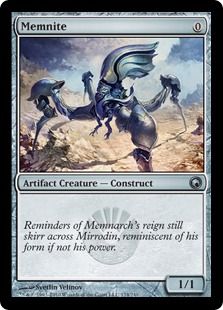

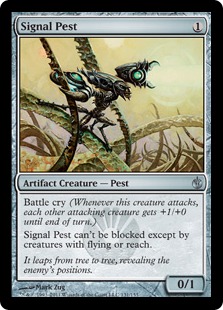

“Draws like this from Tier 2 decks are why RUG Delver and Landstill are not Tier I.”
I also defeated Smennen in this tournament in three miserably one-sided games that were punctuated with me playing Jace, the Mind Sculptor off Black Lotus on turn 1 with Force of Will backup in the third game. The streak continues, and I improved to 672-0 against Smennen in tournament matches (excluding intentional draws).
I felt like this deck was pretty sweet, well positioned, and everything until I got a chance to see this:
Creatures (8)
Planeswalkers (2)
Lands (15)
Spells (35)
- 1 Sensei's Divining Top
- 1 Brainstorm
- 2 Mana Drain
- 2 Lightning Bolt
- 1 Vampiric Tutor
- 1 Mystical Tutor
- 1 Yawgmoth's Will
- 4 Force of Will
- 1 Sol Ring
- 1 Demonic Tutor
- 1 Hurkyl's Recall
- 1 Time Walk
- 1 Ancestral Recall
- 1 Mana Crypt
- 1 Time Vault
- 1 Merchant Scroll
- 1 Tinker
- 1 Voltaic Key
- 1 Black Lotus
- 1 Mox Emerald
- 1 Mox Jet
- 1 Mox Pearl
- 1 Mox Ruby
- 1 Mox Sapphire
- 1 Nihil Spellbomb
- 3 Mental Misstep
- 2 Flusterstorm

Marc’s deck is simply perfect for the current Vintage field and is basically an absolute triumph with regard to his card choices and positioning in the metagame.
If you check it out and compare his deck to my deck from the side event, they are almost identical, except he has more Dark Confidants and more Snapcaster Mages. The small differences are a really big deal.
The fact that he has four Dark Confidant is the determining factor that makes his deck unquestionably Tier I and my build undeniably Tier I.5. Basically, my after the fact assessment of deckbuilding for this event is:
“Did your blue deck have four copies of Dark Confidant in it?”
If no, your deck was trash.
If yes, your deck was probably sick.
“If you don’t like playing with Bob, tough, play with it anyway.”
Here is where I absolutely failed and was very handily punished for it at Champs. I simply decided that I was not going to play with the card Dark Confidant. My reasoning was, “I don’t want to play with cards that are high risk / high reward.” Meaning, “I don’t want to play with a card that accidently kills me for no reason by flipping a Force of Will or Blightsteel Colossus.”
The problem with this logic is that while Dark Confidant is high risk / high reward, there isn’t a sufficiently powerful counter option to playing with Dark Confidant—meaning there isn’t an option that is low risk / high reward to offset that can reasonably replace Dark Confidant and sustain a high power level of cards in one’s deck.
Dark Confidant is the only good unrestricted option to draw cards in the blue deck that isn’t Jace, the Mind Sculptor, at least for right now.
The inclusion of Dark Confidant lowers Marc’s total CMC in his deck drastically while upping the over all power level, consistency, and redundancy of his deck. I tried to offset blue’s inherent inability to draw cards by going with more of a TurboTezz design and playing with more card advantage cards higher up in the curve (i.e., Thirst, Gifts, more Jace), but all of this is actually achieved more efficiently by playing four Dark Confidant in the maindeck, which unlike Thirst, Gifts, and Jace is a common first turn play.
When I think about it, I have no idea why I wasn’t immediately drawn to playing with four Dark Confidant. I almost universally shy away from playing with the card in my deck and have in fact only played with it in three Vintage tournaments since it has been printed. The irony is that in the three events I played it in (all well over 100+ player events), I had one tournament win (SCG Richmond Power 9) and two Top 4 prize splits (Waterbury + 4 Workshop NE tournament).
So it’s not like I’ve never gotten good results with the card, yet my insistence to not variance lose to my own cards inhibited my ability to accurately identify the Tier 1 strategy. Both of the blue decks in Top 8, Marc’s Grixis deck as well as the Bomberman deck, included four Dark Confidant. It appears the proof is in the pudding, and the blue decks should and will be playing more Bobs moving forward.
The fact that I am of the opinion that Dark Confidant (a high variance card) is really the only premier strategy for blue decks further reflects my opinion about the general nature of Vintage as a format.
My assessment: Vintage is a brutal, brutal format.
Not brutal in the sense that it is bad or unplayable, but brutal in the sense that the Tier I decks really put the screws to their opponents really, really quickly and consistently.
“All the best decks are BIG, LINEAR gambits.”
All of these cards are in one way or another both the defining engine of their respective decks, but they also can be identified as high risk / high reward cards.
Dark Confidant is obviously high risk / high reward because it is undercosted and provides fantastic advantage, but it can randomly kill you if you get unlucky and flip a few high CMC cards.
Workshop and Bazaar are also gambits in my view because any time one is playing a very linearly powerful strategy, it runs the risk of facing off against a player with a draw that can punish the strategy, like lots of Ingot Chewers or Leylines.
All of these decks consistently attack their opponent in a direct, consistent, and linearly powerful way right from the first turn and are constructed to create one-sided blowouts. MUD and Bazaar are pretty straightforward about consistently drawing to the old one-sided blowout, whereas turn 1 Bob is more innocuous but nonetheless efficient at creating and sustaining insurmountable advantage over the course of a two to three turn sprint to completely blowing one’s opponent out.
The reason these three archetypes were the best performing at Vintage Champs and will likely continue to be the best performing moving forward is that all three utilize the best unrestricted cards in the format to immediately create a huge and sustained advantage that grows exponentially as the game moves from turn 1, to 2, to 3, etc.
Here is the mantra that I learned from observing and playing a lot of tournament Vintage this past week:
“The best decks in the format all maximize their POWER and CONSISTENCY over the course of a long tournament by playing with the most impactful unrestricted spells that CAN and DO come down on the first turn and quickly generate insurmountable advantage.”
The most important cards that specifically factor into this observation are of course:
Lodestone Golem
Bazaar of Baghdad
Dark Confidant
Let me elaborate on why this statement is “the way it is” and why it is important to understand this dynamic moving forward.
Imagine that you are sitting down in the dark against an unknown opponent and are on the draw but not playing one of these cards as a four-of in your deck. Now imagine that you fan out your opening hand. What percentage of hands can your deck draw that can beat all three of these commonplace opening starts? Force of Will is pretty saucy against two of the three, but keep in mind that in order to answer their four-of card, you pay a life and go down a card. So how good of an answer is FOW to Dark Confidant, really? I’d probably do it, but I’m just saying…
Now imagine that your draw with a Tier 1.5 deck is on the play. How many of your draws are going to be outclassed simply by one of these three cards hitting the battlefield and recouping the positional advantage of you having the play?
Here is the gold mine: in general, and I am factoring in post-board games into my equation, having one of the unrestricted Power 3 (Lodestone, Bob, or Bazaar) on the play is favored to win the game against not only all of the Tier 1.5 and below decks but also against opposing Power 3 decks.
If I’m on the play and I slam down a Dark Confidant against Workshops, I will win the majority of the time. If I’m on the play with Lodestone Golem, I’m favored to win most of the time, and if I drop a Bazaar on the play I am favored to win most of the time. Now it does get tricky that it is very possible to have turn 1 Bob and lose to a Bazaar in the first game, but after sideboard when you have multiple Jailers, Cages, Spellbombs, etc., it seems like a very good start.
In the blue versus Workshop matchup a lot of energy is spent fighting over Lodestone Golems and trying to deploy Dark Confidants. These cards are key in the battles between the Tier 1 decks and simply put the decks that don’t play with them on the back foot from the first turn forward.
Dark Confidant is probably the least linear of these cards because it doesn’t inhibit one’s strategy to playing “all graveyard cards” or “all artifacts” for a very high linear pay off. But instead it is a gambit of I get to play all the best cards and get this turn 1 play that creates card advantage, as well as blocks to soak up damage and can combat opposing Jace, Mind Sculptors against the blue decks that don’t play Bob.
Every single deck in the Vintage Champs Top 8 had one of the following:
4 Dark Confidant
4 Lodestone Golem
4 Bazaar of Baghdad
The only important decision that anybody who played in Vintage Champs had to make was the decision to recognize that these three unrestricted cards are absolutely bananas and include four copies in their deck or make the incorrect decision to not include these cards and thus be removed Top 8 contention. Understanding this dynamic was not as well established (clearly) as it is now in the wake of the tournament being played out, but I think it is fairly clear at this point what the difference between great decks and mediocre decks in Vintage is going to be moving forward.
I would further like to assert one more piece of important evidence that I think substantiates my claim about these new pillars being absolutely paramount moving forward as we attempt to understand the Vintage metagame. As I observed the Top 8, I found it to be absolutely riddled by mediocre / poor technical play to the point that of the ten games I actually watched, three of them were decided by very, very obvious punts that caused a player to lose a game instead of win a game.
- A Workshop player had Kuldotha Forgemaster, Mox Emerald, and another irrelevant artifact in play along with Ancient Tomb and another land untapped. He played Wasteland and activated it against his opponent’s board of Tundra and Mox Sapphire. His opponent responded by floating and casting Hurkyl’s Recall when he declared attackers to drain the U out of the pool. The Workshop player let it resolve, when he should have in fact sacrificed his board to the Forgemaster, Tutored for Trinisphere, allowed the Hurkyl’s to resolve, and then replayed the 3ball. His follow up play would have been to drop a Revoker under the Trinisphere naming his opponent’s lone mana source, Mox Sapphire, and left the Bomberman player drawing to runner, runner, runner lands in order to even cast a spell.
- A Dredge player needed either a land or a Narcomoeba to make Zombies to survive a Blightsteel Colossus—either card would have saved him because he had Bloodghasts in the bin. There were only two Narcos left in deck. He dredged and missed instead of drawing to the land when he had better odds of hitting land than Narcos. Top card was obviously a land when he dredged.
- In the finals, a Workshop player had double Phyrexian Revoker on the first turn and didn’t use both to name Marc’s turn 1 Jace, the Mind Sculptor. Marc promptly Ingot Chewered the Revoker naming Jace and easily won the game by getting to Brainstorm, whereas if he didn’t get to Brainstorm on that turn he probably would have ended up losing the game despite having slammed a turn 1 Jace, the Mind Sculptor.
- After a Workshop player Revokered a Bomberman player’s Time Vault, he spent his next turn Demonic Tutoring for Black Lotus, which was basically a do-nothing. From my understanding the tactical line was if the Shop player had no relevant plays for two consecutive turns, he’d be able to combo with the Salvager. Unsurprisingly, Shop played a Sphere, and the game was lost.
Now I understand that when the pressure is on that sometimes players make bad choices or miss certain things and that is part of the game. I am also specifically not saying that the players who made Top 8 at Vintage Champs are bad or that they didn’t deserve to make Top 8. For starters, Raf Forino played some fantastic Magic in the Top 8 that I was able to observe, and from the two matches I watched of Marc Lanigra, I thought his play tight, smart, and that I wouldn’t have made a single different play than he did. I was disappointed that in Raf and Marc’s match Raf’s poor draws basically lost it for him because with better hands that might have been a really, really fun match to watch.
Nevertheless, I think that with all things said and done, Marc was the player who most deserved to win the tournament for two reasons. One, he was, at least from what I saw, by far the most technically proficient player in the Top 8 (and the other player I thought that could beat him, Raf, got killed by bad draws). Two, he figured out the rule that you must play four Bob, four Lodestone, or four Bazaar to be successful in Vintage right now.
The point is that in order to be the champion, like Marc, you have to have the good deck and play it very well. However, I think that under these conditions point two, having the right deck, is actually far, far, far more important than point one, play your deck well.
Look no further than the players left behind from this Top 8 to see this important fact put into practice:
“IT’S A TRAP!!!”
DeMars (Me): 0-4 (Delver) (3 Champs T8)
Smennen: 1-2-1 (Gush) (3 Champs T8)
Mastriano: 6-2 (Delver) (3 Champs T8)
Joe Brown: 2-2 (Bomberman, no Bobs) (Don’t know, but he’s really good.)
Elias: Dead by round 4 (Landstill)
Soly: 6-2 (with two byes) (Delver) (2 Champs T8)
Jimmy M: 6-2 (Delver) (Champs T8)
Kevin Cron: 3-3 DED (2 Champs T8)
Hiromichi Itou: DED (Former Vintage Champ, Champs T8)
David Williams: 3-2 (Landstill) (Is David Williams!)
These are all very good and consistently performing Vintage players who all fell very short of the goal and had disappointing tournaments. Do you notice anything about this list? None of these players figured out that they needed to have one of the Power 3 unrestricted cards in their deck in order to be playing an actually good deck. Everybody here fell into the trap of putting too much credence on decks that were recently successful in the metagame and gimmicky decks like Delver and Landstill, with the delusion that these decks were well positioned and gave them a better ability to ‘outplay’ the competition or ‘control their own destiny.’
Here are questions that I am interested in seeing played out for Vintage in the future:
Although it didn’t quite get there, Oath of Druids hung around in the tournament for a long time before ultimately meeting the same end as RUG. Is it possible that Oath of Druids as a strategy has the ability to position itself at the top of the metagame in the same way that Golem, Bob, and BoB (Bazaar of Baghdad—two of the best unrestricted Vintage cards are BOB!) have?
It functionally does the same things as the previous three—it’s unrestricted and is a turn 1 play that dominates the game. The question is: is it good enough? If there is any deck in the metagame that could prop itself up alongside the current three-headed monster, I think it is Oath, simply because it has an insane unrestricted card like the others do. We shall see.
Well, now you know, and knowing is half the battle. My prediction is that these archetypes will continue to dominate the landscape. As Chapin would so eloquently put it:
“It’s Lodestone Golem, Dark Confidant, and Bazaar of Baghdad’s world—we are just living in it…”
With all of that having been said, Gen Con, as always was an absolute blast, and getting to cast Black Lotus and Ancestral Recall in the company of good friends and good people was everything I hoped it would be. 0-4, oh well. That was more than a little bit disappointing, but I got sucked into the Delver trap and my result is exactly what I deserved to get. We learn from it, and we move forward.
Hope you enjoyed the article, and thanks for reading!
Cheers,
Brian DeMars


